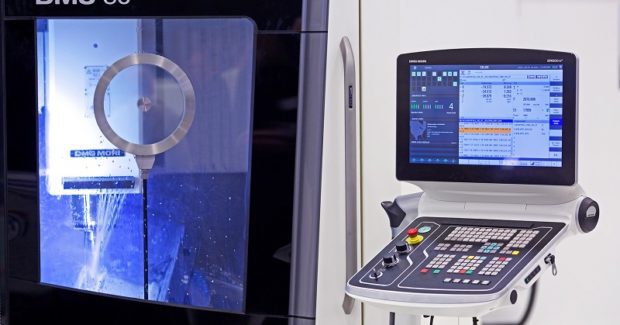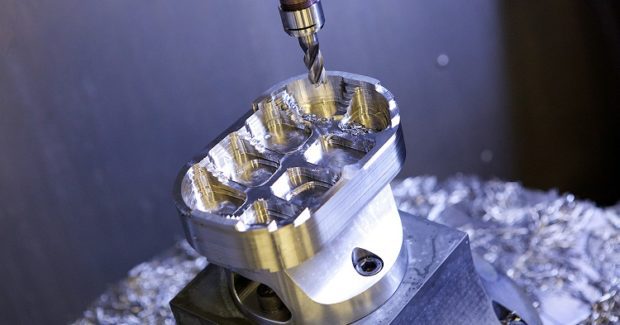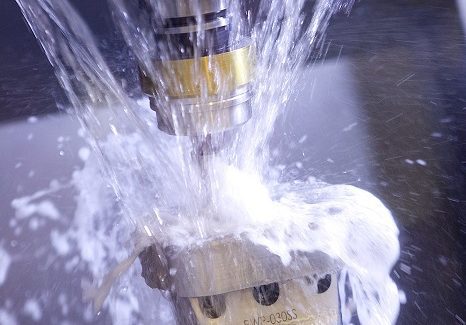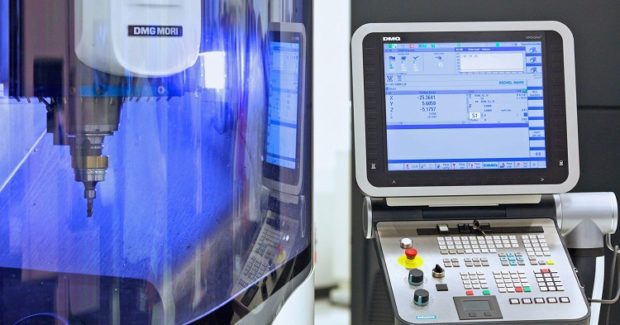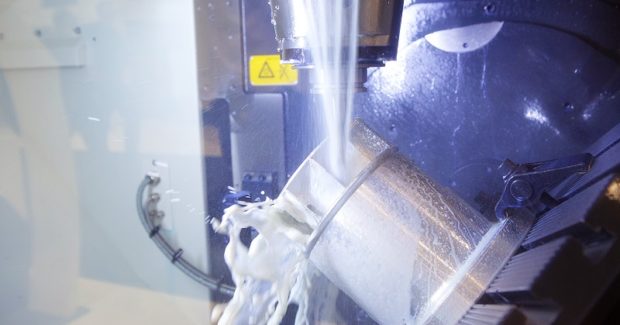Take 5-Axis Machining of Aerospace Parts to the Next Level
Machining aerospace components involves very long cycle times and often high raw material costs that present competitive challenges for OEMs and production job shops alike. But here are two examples of how the latest CAD-CAM-CNC workflow can improve design-to-part protocols, machining time, tool life, surface finish, dimensional accuracies and overall production efficiencies.
Posted: May 21, 2018
Machining aerospace components made from lightweight but hard materials, such as titanium and related alloys, or aluminum workpieces where substantial volumes of material removal occurs, such as fan blades and bladed disks (blisks), involve very long cycle times and often high raw material costs that present competitive challenges for OEMs and production job shops alike. To help them substantially improve every aspect of part production, machine tool builder DMG MORI (Hoffman Estates, IL) partnered with Siemens Industry, Inc. (Elk Grove Village, IL) on a total package of CAD-CAM-CNC hardware, software and engineering services that reduce design-to-part protocols and improve machining time, tool life, surface finish, dimensional accuracies and overall production efficiencies.
For example, a reverse thrust component for a jet engine was made from Ti Gal-4-V, a material often preferred for its elastic stiffness, using an Ultrasonic 65 machining center with a Sinumerik 840D sl CNC. Starting from the CAD file, the NX CAM program used a VoluMill add-on feature to calculate maximum material removal rates. The User Defined Events (UDEs) feature inside the NX program allowed simple check boxes for triggering post-processor references for coolant pressure, amplitude, ultrasonic generator settings and more. This avoids manual programming and, as a result, reduced the program transition time from as long as two days to approximately 30 minutes. Once the program was ready for the control, the CNC allowed a more streamlined simulation of the actual cutting path. The 3D quick set compressor feature provided a parametric itemized data file for all path motions, thereby eliminating collision and ensuring the optimum tool path, in conjunction with the NC kernel and PLC on the machine tool.
“This feature is a huge time saver because the test ball and probe in the spindle mechanism can be run at any point in the cycle, testing the actual machine kinematics at any time,” explained Randy Pearson, the technical applications center manager at Siemens. “This procedure can also be automated to run on the table at prescribed time intervals.” The high speed machining feature is highlighted by Cycle 800, a static plane transformation that allows a 5-axis machine to define a rotated working plane in space (commonly known as 3+2 programming). The cycle converts the actual workpiece zero and tool offsets to refer to the rotated surface. It also accommodates particular machine kinematics and positions the physical axes normal to the working plane, referenced as TRAORI (or transformation orientation). Meanwhile, the Sinumerik CNC Operate user interface on the machine allowed the operator to perform a variety of integrated tool management and information management functions, all transportable on a USB or network connection.
In the simulation, the loading and fixturing of the workpiece was performed virtually in NX CAM, which also calculated a consistent chip load that is critical in these large material removal applications. The simulation further verified the tool length at every cutting section and finalized the program for the machine to begin. This is literally like working with a “Digital Twin” of the machine. During production, this process yielded a 2.25X improvement in tool life on this very hard material. “With the combination of NX CAM plus the Sinumerik 840D sl CNC, we have a lot more input on the creation of the tool path,” noted Luke Ivaska, the national product manager of advanced technologies at DMG. “I have yet to find a problem I could not solve with NX.” The finished part is now run in 4.5 hours with a surface finish improvement from 62.5 Ra to 35 Ra, due to the ultrasonic actor.
In another example, an entry-level DMU 50 5-axis machining center was utilized to cut a 7 in diameter x 2 in high block of 6061 aluminum into an impeller fan for an aerospace application, with more than 90 percent material removal achieved. The same NX CAM software began this process chain with the initial benefit of considerable time savings in the 5-axis setup and comprehensive G-code simulation and verification in a single system. Because of the bladed structure of this component, only a 0.5 deg clearance between the part and the tool holder was allowable during machining. Simulation with NX CAM was key to getting in that tight of a spot without collision of tool and part, and a slim line tool holder from Haimer USA (Villa Park, IL) was used for this application. Meanwhile, the interpolated tool axis and section views were run on NX CAM to verify the operation of the tool in this very tight workspace.
In the Sinumerik 840D sl, the same 3D quick set compressor feature ensured the proper tool path while the high speed machining setup and Cycle 800 were again utilized. The Sinumerik Operate graphical user interface on the CNC provided the operator and engineers with full access to a variety of conditions in production, including all roughing and finishing data in plain text, plus all 5-axis transformation orientation data logged for restart after any interruption and manual restart. The variable streamline operation of the DMU 50 combined with an interpolated vector to produce a smoother finish in the machining of the blade surfaces in a single tool path. The machine seamlessly transitions from square-to-round machining and then to the extreme angle paths needed to accurately machine the blade internals. The single blade fin portion of the program was automatically captured, so a step-and-repeat program can be built-up.
The simulation of each blade fin cutting path was done on both the NX CAM and the CNC programs. This vectored program is transportable to any machine with comparable results. “Because the machine kinematics are knowable, once this program is created it can be transferred onto multiple machines within the same facility or run by shops around the world, all tied together by the control, so there is total continuity between the operations, the data capture protocol and feedback received for production analysis,” stated Pearson and Matthias Leinberger, the director of business development for Siemens PLM. Both of these aerospace components were machined using CELOS® onboard each machine tool to facilitate the total interaction between operator and machine with numerous apps that enable instant call-up of actual conditions, full data comparison through a link to CAD and CAM software, plus full interface to an ERP system for logging and analysis, with in-process remote adjustment. Interactive communication to a global production network is also provided.
DMG MORI, 2400 Huntington Boulevard, Hoffman Estates, IL 60192, 847-593-5400, Fax: 847-593-5433, www.dmgmori.com.
Siemens Industry, Inc., Motion Control Business, 390 Kent Avenue, Elk Grove Village, IL 60007, 847-640-1595, www.siemenscnc.com.
Haimer USA, 134 E Hill Street, Villa Park, IL 60181, 630-833-1500, Fax: 630-833-1507, www.haimer-usa.com.

